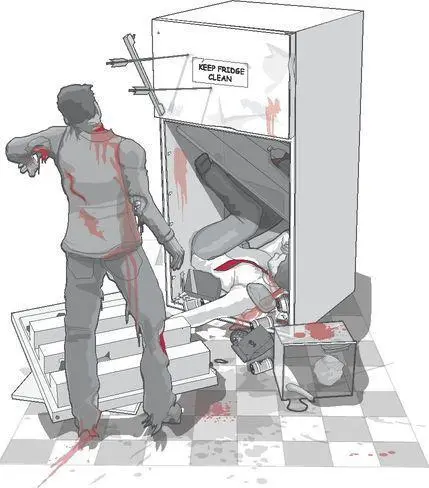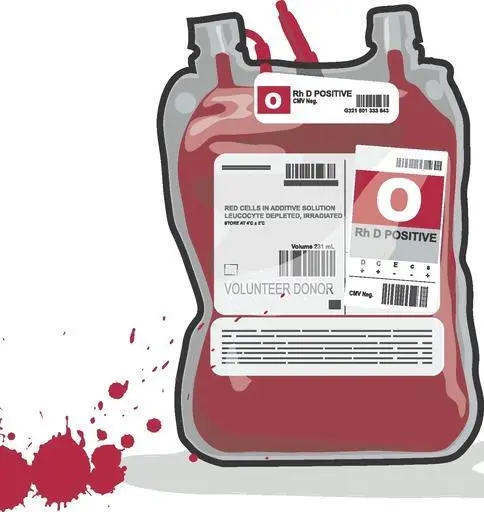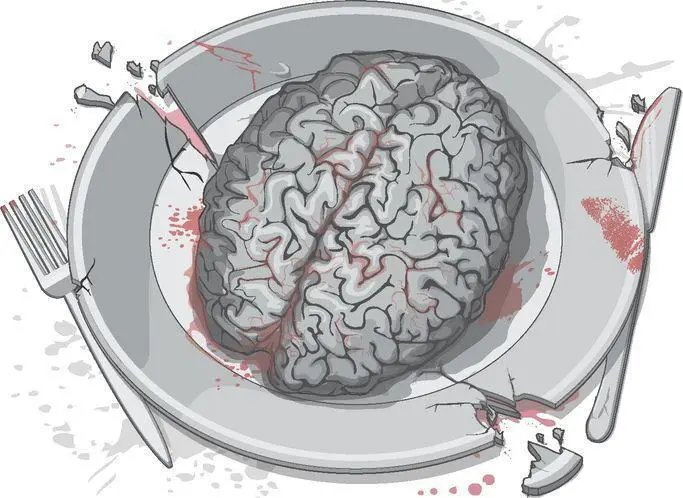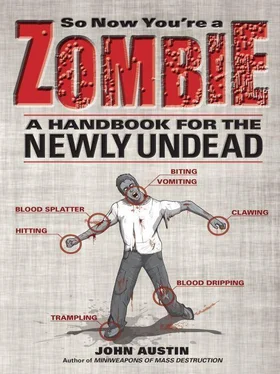d. Run and hide.


You’ve hunted and subdued a human target, and now comes the main event—it’s feeding time!
As mentioned earlier, your hunger for living flesh is more than an unquenchable craving. It’s a biological necessity. Contrary to popular human belief, the undead body still relies on the food in its digestive tract to function. But instead of using specialized organs to extract energy and nutrients, the tract now acts as a holding cavity. As flesh passes through the tract, the z-virus absorbs the acids of some of the 10 trillion cells found in the living body. This creates the energy the virus needs to stave off decomposition (see “Post-life Expectancy,” page 28).
Because a zed that stops feeding will slowly starve to complete decomposition, and because living food is often difficult to obtain, the z-virus must encourage its host to hunt relentlessly to ensure its own survival. During the reanimation process, your brain underwent mutation. The virus modified the region of the brain that regulates feeding so that it constantly stimulates the body’s hunger signals. The result is that you’re always hungry for … well, you know the rest.
Zeds are capable of consuming a wide variety of live flesh, no matter what the size, species, or hairball risk. But although you can make do eating other animals during down time, for maximum nutritional value we encourage you to feed on the number one zombie delicacy: fresh human brain tissue, pinkish on the outside and white on the inside.
So, what’s so special about the human brain? It’s filled with billions of highly specialized sensory cells brimming with electrochemical pulses. When consumed, these particular cells create an intense concentration of biological energy, significantly reducing your monthly flesh requirements. A few bites of brain and you’ll suddenly feel what is called a medulla rush , an adrenaline burst that increases your mobility.

How to Use the Pyramid The recommended number of servings for each food group for a functional adult zombie per month (30 nights).
This zombie food pyramid suggests the number of servings of brain and other human meat you should consume per month for optimal nutrition. The chart is based on the average-sized human; if dining on children, adjust quantities accordingly.
Your life expectancy will greatly increase as your energy intake from human flesh increases. However, gorging can lead to a ruptured stomach, so it is important that you eat responsibly. In addition, rotten meat and aged blood can prove fatal. Bodies that have been dead longer than 12 hours should generally not be consumed. Higher and lower temperatures may decrease or increase this timeframe; use your zombie senses to make a final determination of freshness (see “Rotten Is a No-No,” page 112).
Brain Group
You haven’t really “died” until you’ve tried human brain! Even though it only accounts for 2 percent of your victim’s body weight, it represents the most important group on the Zombie Food Pyramid. Recommended monthly consumption of gray matter is approximately 3 pounds, or half a brain per sitting. Note that the upper spine is also considered part of the Brain Group.
The brain of your victim will be protected by the skull. However, once you remove his or her lower jaw, it can easily be accessed. As stated earlier, eating a brain will give you a medulla rush, increasing your mobility with a burst of adrenaline. For up to 24 hours after consuming brain, zombies are capable of running and jumping, which will improve their hunting and attacking skills.

Internal Organ Group
The heart, lungs, liver, pancreas, intestines, and other organs in the chest and abdomen are all suitable for eating. However, unlike organs in the Brain Group, your monthly intake should be 8-10 pounds, or roughly 144 ounces. That’s a couple lungs, a few hearts, and a liver or two. So depending on the number of zombies in your horde, you will need multiple bodies to fulfill your internal organ requirement. Alternatively, feedings from this group can be replaced with additional servings from the Brain or Blood Groups.
Most of the gooey goodies in the Internal Organ Group are protected by your victim’s rib cage. Though it is not difficult to break the rib cage, you can just as easily reach under the ribs and extract the organs by hand.

Blood Group
It is essential to keep your body hydrated in order to absorb much-needed energy from uninfected flesh. Human blood is an excellent source of hydration.
Unlike vampires, who are obsessed with sucking, you can consume blood simply by eating flesh—the living human body uses blood to transport nutrients and oxygen to every cell in the body. Full-sized adults contain an average of 5.3 quarts of blood, making up roughly 7 percent of their body weight. This represents about two-thirds of your recommended monthly allowance. However, it’s virtually impossible to extract that amount of blood from a single human in one sitting.
Don’t be concerned about mixing blood types (A, B, AB, O). Consumption of incompatible blood types will not cause complications, though it has been observed that type O blood can give you the shakes.

Bone Marrow Group
The Bone Marrow Group, also known as the Table Scrap Group, is typically what is left after a hungry horde fully consumes a body. The human body should have 206 bones, each one filled with red and yellow marrow. This marrow is made up of juicy blood cells. For minimal nutrition, we suggest 10-20 servings, though optimal nutrition is much higher—30-40 servings.
Servings from the Bone Marrow Group can be replaced by additional servings from the Brain or Blood Group, if available—that’s what you really crave, after all. But leftover marrow will keep you on your feet until you have an opportunity to hunt down something more satisfying.
Bone marrow can be difficult to extract, but try to avoid stuffing full bones into your body. Bones such as the femur (the thigh bone) are large and can cause complications in your absorption tract. Finger and toes, on the other hand, can be consumed whole.

Proper zombie feeding etiquette can mean the difference between feasting on a fresh kill and foraging for rodents.

Don’t Start Eating Until Your Victim Is Ready
Wounded humans will continually attempt to escape your clutches by fleeing or fighting. Even if they are experiencing early symptoms of z-virus infection, until paralysis sets in they are capable of inflicting damage.
Читать дальше




















